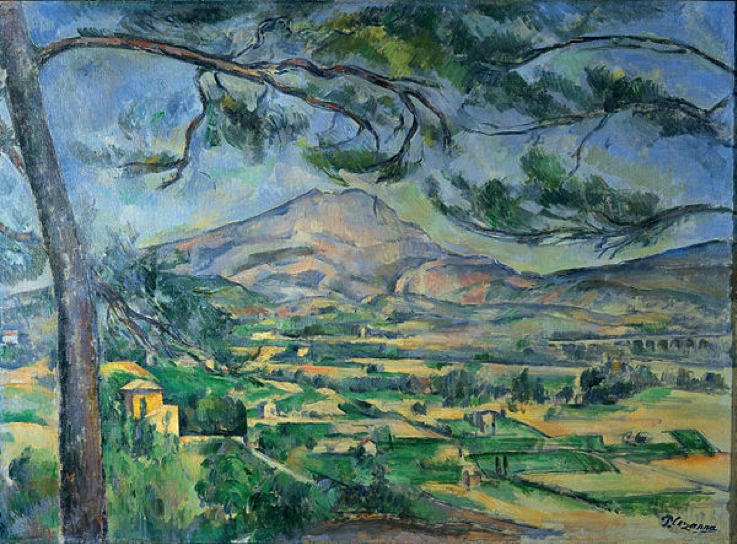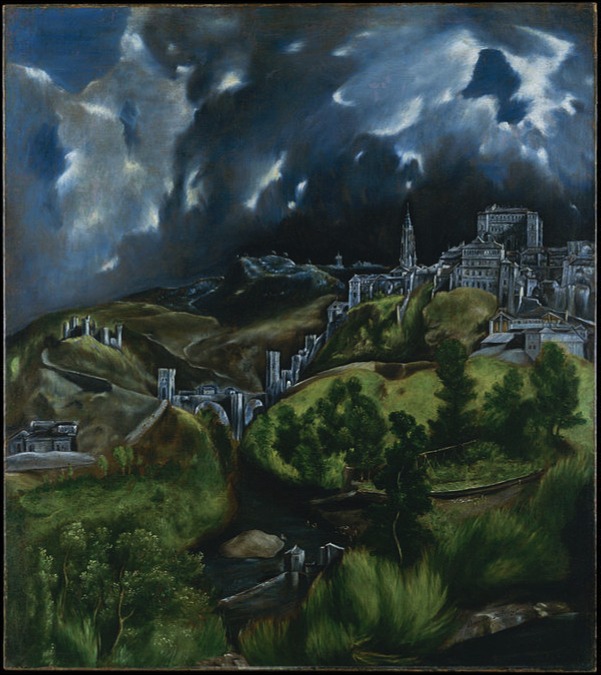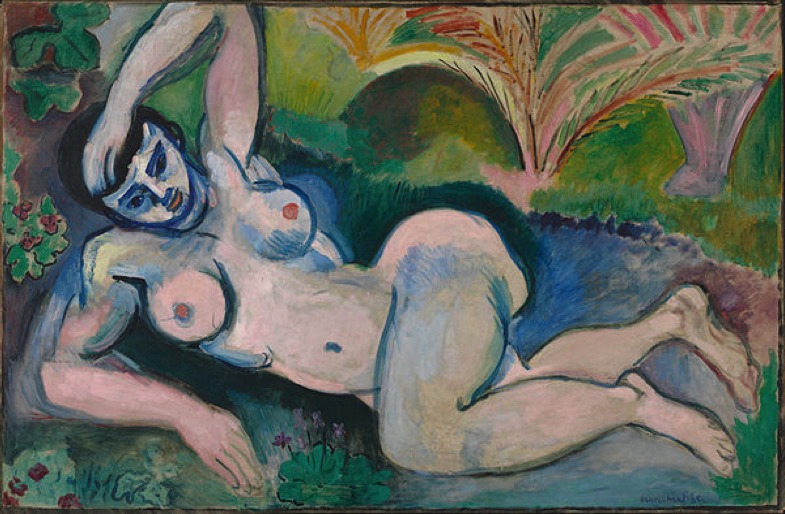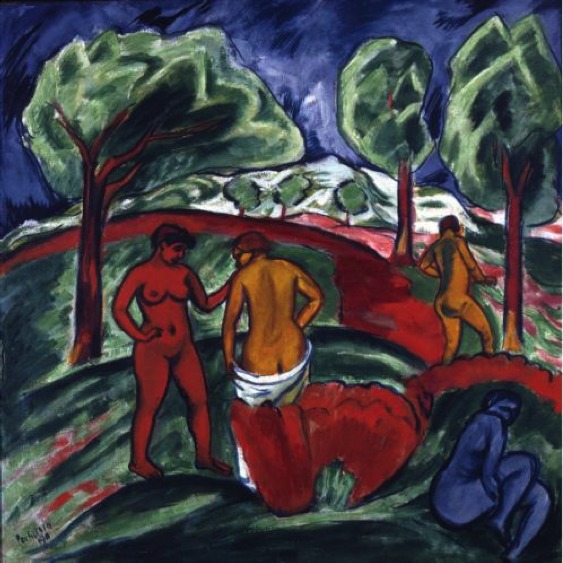Both an independent artist and a crucial member of the German Expressionist collective The Bridge, Max Pechstein (1881-1955) weaves himself into the lively, transnational dialogue of modernism in the early twentieth century. Trained as an academic artist and decorator, Pechstein’s rise as an artist twentieth century was colored with a variety of influences, all of which occupy a distinct niche in his own expressive style. Day of Steel, 1911 (Figure 1) reflects a rejuvenating confluence of artistic paradigms used by Matisse in Bathers with a Turtle, 1907-8 (Cat. 1, Figure 1). Day of Steel revises traditional motifs of the bather’s scene and the classical body with painterly brushwork and arbitrary colors, and brings past and present artistic tropes together in this way to create its own distinct aesthetic.
A native of the German Saxon countryside, Pechstein carried an interest in natural landscapes and subjects with him when he moved to the city of Dresden. He sought professional training as a studio and decorative artist during his studies at the Dresden Art Academy. There, Pechstein was trained in academic painting, and became familiar with the trending decorative style of Art Nouveau.[i] His later journeys to Paris and Northern Italy exposed him to paintings of Old Masters such as Boticelli and Giotto, and to the conventions of classical Greek and Roman sculpture, Gothic and Italian Renaissance art.[ii] The idealized proportions of the nudes in Day of Steel are most emblematic of this influence, along with the positions of the nudes in the landscape. The three center figures display different sides of the bodies—front, back, and side—in an attempt to represent all sides of the figure, as did many Renaissance artists, such as Albrecht Dürer in his engraving The Four Witches, 1497 (Museum of Fine Arts Budapest), to negotiate three dimensionality with the restriction of a flat canvas.
[i] Bernhard Fulda and Aya Soika, Max Pechstein: The Rise and Fall of Expressionism (Berlin and Boston: Walter De Gruyter GmbH &, 2012), 21.
[ii] Bernhard and Soika, Max Pechstein: The Rise and Fall of Expressionism, 47.

Figure 2. Paul Cézanne, Mount Sainte Victoire with Large Pine, 1887
Oil on canvas, 246.4 x 36.2 in/
Courtauld Institute of Art.
Pechstein also draws from important predecessors to Expressionism in Day of Steel. Following his move to Dresden, Pechstein encountered the work of Neo-Impressionist artists of the nineteenth century in Dresden’s galleries, and he became inspired by the landscapes of Paul Cézanne and the expressive quality of van Gogh’s color and brushwork.[i] The mountainous figure that lines the horizon of Day of Steel is reminiscent of Cézanne’s paintings of Mount Sainte-Victoire, such as his Mount Sainte-Victoire with Large Pine, 1887 (Figure 2). The looming white mountain on the high horizon line of Day of Steel brings together the turbulent atmosphere of the clashing colors and warped forms of the painting just as Cézanne’s monolith looms over so many of his paintings.[ii] Pechstein’s thick, crooked brushwork and patches of pure color also work to alter the viewer’s perception of depth that is evocative of a Van Gogh landscape. Instead of being led in a linear journey from foreground to background, the viewer’s eye is jostled through the painting’s crudely contoured topography in a manner similar to the Dutch Post-Impressionist’s works.

Figure 3. El Greco, View of Toledo, 1596-1600.
Oil on canvas, 47.8 x 42.8 in.
Metropolitan Museum of Art.
Pechstein’s awareness of canonical figures of art history also derives from the writings of Julius Meier-Graefe, the German art critic of the early twentieth century who published various manuscripts tracing the evolution of modernist painting.[i] Meier-Graefe contributed to the German Expressionist’s recognition of figures like van Gogh and Cézanne, and brought earlier painters such as Titian and El Greco to the forefront of the modernist consciousness.[ii] The warped figures of Pechstein’s trees and his use of stark ivory highlights in Day of Steel could be the influence of the atmospheric and expressive contrasts found in El Greco’s paintings, which Pechstein would have encountered in Meier-Graefe’s Impressionisten, published in 1907.[iii] The Prussian blue sky and high horizon line in Pechstein’s painting is especially evocative of the Spanish master’s View of Toledo, 1596-1600 (Figure 3). Moreover, the “steeling,” rejuvenating effect of Pechstein’s loose, painterly style of the harsh white highlights in the sky echo the steel gray sky in View of Toledo and the use of white by El Greco to create an almost-metallic atmosphere. Pechstein engages with El Greco’s expressionistic strokes and high-contrast aesthetic in his painting, and Day of Steel appears to salute the Spanish Old Master’s early plunge into modern painting.
Pechstein, however, clearly moves forward from these canonical influences with his frenetic brushwork and departure from naturalism in Day of Steel. Pechstein worked on this piece while he was living in Dresden, which was a city with a large avant-garde presence. Dresden’s museums and exhibitions in commercial galleries often featured progressive artists such as Wassily Kandinsky. Pechstein quickly became incorporated into the vanguard expressionist group The Bridge after meeting member Erich Heckel in 1906.[iv] The influences of The Bridge’s style began to circle in on Pechstein’s work, and his brushwork in Day of Steel reflects the group’s emphasis on uncontrolled and unmediated expression, and varies in thickness across the canvas. His colors are pure and far from naturalistic in most areas; the vermilion and ochre of the bodies and the flora clash with the greens of the hillside almost violently. Pechstein uses in blocks with little contrast or variation within hues, characteristic of The Bridge’s aesthetic that consolidated the abbreviated strokes of van Gogh and Fauves like Henri Matisse. The Bridge artists also provided Pechstein an introduction to primitivism and non-Western art, and also with the vision of a modern Arcadian paradise that he captures in Day of Steel. The presence of the central bather’s towel grounds the painting in modernity as an object of leisure time, and the artists depict an intermediate between civilization and primitivism in the spirit of The Bridge’s philosophy.
[i] Scholz-Hänsel, Michael, and Wismer, Beat. El Greco and Modernism. (Ostfildern: Hatje Cantz Verlag, 2012), 21.
[ii] Scholz-Hänsel and Wismer, El Greco and Modernism, 21.
[iii] Scholz-Hänsel and Wismer, El Greco and Modernism, 21.
[iv] Bernhard and Soika, Max Pechstein: The Rise and Fall of Expressionism, 36.

Figure 4. Henri Matisse, Blue Nude (Souvenir of Biskra), 1907.
Oil on canvas, 33.6 x 55.2 in.
Baltimore Museum of Art.
Unlike many members of the Bridge, however, Pechstein’s style was considered more “French,” and engaged openly with the styles of Matisse and the Fauves.[i] This was largely due to the time that Pechstein spent in Paris in 1907, and the first-hand experience he had with modernism in France.[ii] Pechstein’s blue and green hues in Day of Steel echo a common color scheme of Matisse, such as that found in Bathers with a Turtle, 1908 (Cat.1, Figure 1). The blue figure in the far left corner of Day of Steel both departs from the classicized figures in the center of the canvas, and resembles the abstracted, primitivist nudes of Henri Matisse, such as Blue Nude (Memory of Biskra), 1907 (Figure 3). The simplified features and pose of Pechstein’s enigmatic blue nude imitate the mask-like faces of Matisse’s subject, and the electric blue exaggerates the muddle of colors in Blue Nude. Pechstein would later develop his own interactions with primitivism and non-western art through his trip to the South Seas right before the outbreak of World War I, and his engagement with “primitivism” of The Bridge and the fauves foreshadow elements of his later style.[iii]
During 1911, however, the inspirations of his predecessors and contemporaries are the crux of Pechstein’s oeuvre in Day of Steel. The swirling, turbulent brush strokes and loud colors of the German expressionists come together with both academic painting and the influences of the road to modernism. In this picture, bathing is paired with the baptism of his style of conflating the perspectives of those before and around him. Pechstein’s painting and reservoir of visual influences continues to expand beyond Day of Steel as he further explores the world of non-western art in Palau and the South seas,[iv] and as he maintains a critical and informed eye for his place in the path of art history.
[i] Javier Arnoldo. Brücke: El Nacimiento Del Expresionismo Alemán. Madrid: Fundación Colección Thyssen-Bornemisza, 2005, 319.
[ii] Arnoldo, Brücke: El Nacimiento Del Expresionismo Alemán, 319.
[iii] Bernhard and Soika, Max Pechstein: The Rise and Fall of Expressionism, 49.
[iv] Bernhard and Soika, Max Pechstein: The Rise and Fall of Expressionism, 147.
